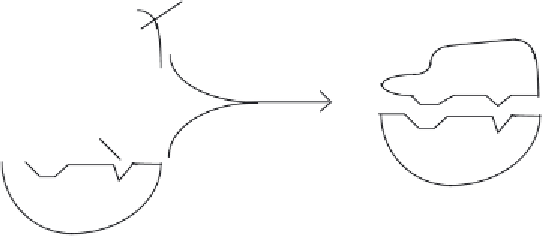Biomedical Engineering Reference
In-Depth Information
One molecule of hirudin binds a single molecule of thrombin with very high affi nity (
K
d
≈
10
12
mol l
1
). Binding and inactivation occur as a two-step mechanism. The C-terminal region of
hirudin fi rst binds along a groove on the surface of thrombin, resulting in a small conformational
change of the enzyme. This then facilitates binding of the N-terminal region to the active site area
(Figure 12.8). Binding of hirudin inhibits all the major functions of thrombin. Fragments of hiru-
din can also bind thrombin, but will generally only inhibit some of thrombin's range of activities.
For example, binding of an N-terminal hirudin fragment to thrombin inhibits only the thrombin
catalytic activity.
Hirudin displays several potential therapeutic advantages as an anticoagulant. These include:
•
it acts directly upon thrombin;
•
it does not require a cofactor;
•
it is less likely than many other anticoagulants to induce unintentional haemorrhage;
•
it is a weak immunogen.
Although the therapeutic potential of hirudin was appreciated for many years, insuffi cient mate-
rial could be purifi ed from the native source to support clinical trials, never mind its widespread
medical application. The hirudin gene was cloned in the 1980s, and it has subsequently been ex-
pressed in a number of recombinant systems, including
E. coli, Bacillis subtilis
and
Saccharomy-
ces cerevisiae
. A recombinant hirudin (tradename Refl udan) was fi rst approved for general medi-
cal use in 1997. The recombinant production system was constructed by insertion (via a plasmid)
of a synthetic hirudin gene into a strain of
S. cerevisiae
. The yeast cells secrete the product, which
is then purifi ed by various fractionation techniques (Figure 12.9). The recombinant molecule dis-
plays a slightly altered amino acid sequence compared with the native product. Its fi rst two amino
acids, leucine and threonine, replace two valines of native hirudin. It is also devoid of the sulfate
Hirudin
N terminal region
Active site
region
Inactive Hirudin-Thrombin
complex
Thrombin
Figure 12.8
Binding of hirudin to thrombin, thus inactivating this activated coagulation factor


Search WWH ::

Custom Search